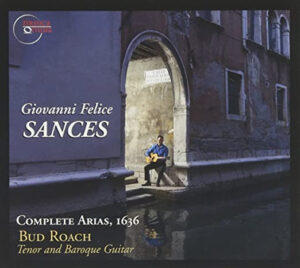Program: #23-16 Air Date: Apr 17, 2023
To listen to this show, you must first LOG IN. If you have already logged in, but you are still seeing this message, please SUBSCRIBE or UPGRADE your subscriber level today.
This Canadian ensemble, founded by tenor and baroque guitar soloists Bud Roach, has an extensive set of recordings mostly of 17th century repertoire; this week we share three of them, including works by Sances, Grandi, and Alessandro Scarlatti.
NOTE: All of the music on this program features the Capella Intima directed by Bud Roach. They are all available on the Musica Omnia label. For information about the ensemble: capellaintima.com
I. Sospiro (Musica Omnia CD mo 0506).
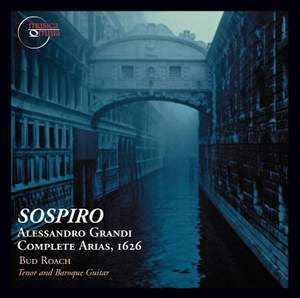
This is the première recording of Alessandro Grandi’s complete arias for solo voice from his third volume of 1626, performed here by tenor Bud Roach as they would have been commonly heard at the time of their publication: with the singer accompanying himself on the baroque guitar. A contemporary of Claudio Monteverdi, Grandi found his greatest success with cantatas and arias for solo voice. These secular songs were among the most popular in Venice throughout the third decade of the 17th century, and are considered to represent the apogee of the genre. Like many of the song collections published by Vincenti, this volume includes “alfabeto” notation for the strummed Spanish guitar.
| 1 | Troppo, troppo fedele | 2:01 | |
| 2 | Deh, mvaga mia Clori | 4:07 | |
| 3 | E si grave'l tormento | 2:53 | |
| 4 | Consenti pur e ti pieghi | 2:04 | |
| 5 | Ninfa Crudele | 3:44 | |
| 6 | Ridete meco, Amanti | 3:02 | |
| 7 | Non puo ferir Amor | 2:25 | |
| 8 | Quando Amor dentr'un cor prende ricetto | 4:04 | |
| 9 | Sotto aspetto ridente | 3:54 | |
| 10 | Amore io piu non ardo | 3:03 | |
| 11 | Empio cor, piu non ti credo | 2:31 | |
| 12 | Gioite, danzate | 1:48 | |
| 13 | Lontan dal tuo bel volto | 1:48 | |
| 14 | I nostri voti il ciel | 4:22 | |
| 15 | Mai piu duro d'Amor si lunga Guerra | 4:11 | |
| 16 | Rompi rompi mio core | 2:33 | |
| 17 | Al seren del tuo volto | 3:34 | |
| 18 | Io non vo' pianger piu | 2:35 | |
| 19 | Superbetta sei pur colta | 2:37 | |
| 20 | Cruda e proterva | 2:15 | |
| 21 | Folle, folle chi crede | 3:13 | |
| 22 | Sprezzami, Bionda e fuggimi | 2:19 | |
| 23 | Breve e la vita, Amor | 5:33 |
II. Gli equivoci nel sembiante (Musica Omnia CD mo 0803).
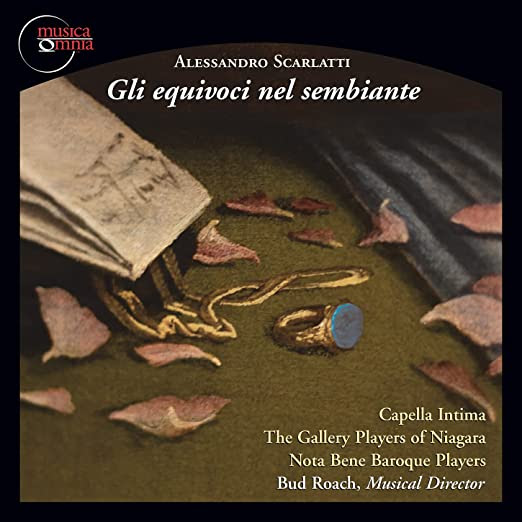
The Canadian vocal quartet Capella Intima, joined by the Gallery Players of Niagara and Nota Bene Baroque Players, is proud to release the premiere recording of Alessandro Scarlatti’s “Gli equivoci nel sembiante”, from 1679, on the historical performance label Musica Omnia.
Mistaken identity, sibling rivalry, and love at first sight are the comic themes of eighteen-year- old Alessandro Scarlatti’s first opera, premiered in Rome in 1679. Despite papal decree against such scandals as women on stage, and a ban on the church’s employment of theatre musicians, the public couldn’t resist the charms of this new, youthful voice of opera. Gli equivoci nel sembiante (Folly in Love) is an intimate comedy for four singers and orchestra that became a hit that toured throughout the regions of Italy for decades.
The Lenten season of 1679 was a cold, rainy, and dreary affair. The new Pope, Innocent XI, was no supporter of the increasingly permissive nature of Roman aristocracy, and he took measures to enforce edicts prohibiting staged performances before a paying public, as well as a general ban on the appearance of women on the stage. Reluctantly granted, however, was permission for private performances, and this concession led to the fortuitous circumstances that made the premiere of Scarlatti's first opera possible-the ingenuity of the Bernini brothers who produced the work; a liberal interpretation of "private performance"; the support and attendance of Queen Christina of Sweden; and, certainly not least, the fact that Pope Innocent had left the city during the carnival, leaving the enforcement of his conservatism to some of the very cardinals who most enjoyed and supported public theatre! Founded in 2008 and led by tenor Bud Roach, the vocal quartet Capella Intima presents unique programming of mainly seventeenth-century repertoire, serving as the ensemble in residence for the HAMMER BAROQUE concert series in Hamilton, Ontario. Programmes such as The Poor Man's Vespers(a hypothetical collection of small-scale psalm settings for churches of modest means), The Paradise of Travellers (Italian repertoire interspersed with the recollections of English travelers on the Grand Tour), and concert performances of Marco Da Gagliano's La Dafne, Purcell's Dido and Aeneas, and Scarlatti's youthful masterpiece presented here, have established the ensemble as a driving force on the Canadian early music scene.
From Early Music America:
With all due respect to the Bach family and the Viennese Strausses, surely no father-son pair of composers enjoys such enduring importance and prominence in the current performance repertory as Alessandro and Domenico Scarlatti. While the latter’s vastly influential keyboard music has gained an increasingly varied recorded profile among pianists as well as harpsichord players, the numerous vocal compositions of the former — often dubbed “the founder of the Neapolitan operatic school” — has not kept pace. The sheer breadth of Alessandro Scarlatti’s output (more than 60 stage works and 500 plus cantatas, plus many sacred settings) is one factor; another is that the composers of, respectively, The Four Seasons and Messiah are household names that “move more product,” in marketing parlance.
German and Austrian forces under such pioneering conductors as Karl Richter, Bernhard Paumgartner, and Hans Stadlmair produced recordings of cantatas such as Su le sponde del Tebro and Il giardino di amore starting in the 1950s, and in recent years Nicholas McGegan and especially René Jacobs have ventured a few Scarlatti studio projects. Jacobs’ outstanding 2007 harmonia mundi issue of 1721’s Griselda, with a stellar cast (Dorothea Röschmann, Lawrence Zazzo, Bernarda Fink, Veronica Cangemi) and the Akademie für alte Musik Berlin, set the bar high but also established that work as a masterpiece both musically and psychologically more incisive than the 1735 opera of the same title composed by the more commercially viable Vivaldi.
Scarlatti’s early opera, Gli equivoci nel sembiante (Folly in Love), dates from 1679, when the Sicily-born composer was not yet 20 and active in Rome. This dramma per musica won him a public and patronage, including that of Sweden’s Queen Christina. It makes a very pleasant impression on the Canadian label Musica Omnia’s well-engineered new recording featuring historically informed performance groups new to me: the Gallery Players of Niagara and Nota Bene Baroque Players.
The Arcadian mistaken-identity-and-
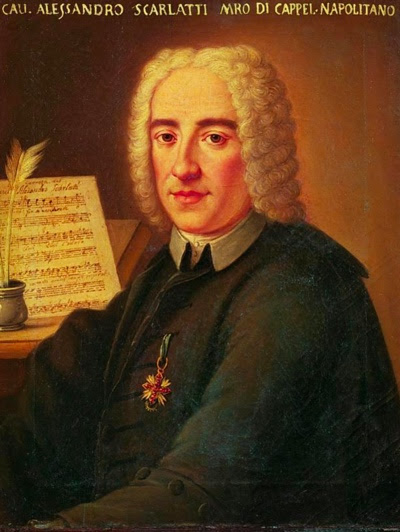
A painting of Alessandro Scarlatti from the 18th century
Bud Roach serves as music director of the six admirably flexible, stylish players (two violins, viola, cello, theorbo/baroque guitar, harpsichord/organ). Roach, a tenor, also sings Eurillo; baritone David Roth takes the music of Arminio, his twin. Vicki St. Pierre and Sheila Dietrich voice Clori and Lisetta, respectively. (In 1679s Rome, it caused some scandal that women performed onstage at all.) The voices are well-trained and pleasant rather than strikingly individual. Roach demonstrates fluency in style, agility in runs, and a forward, earnest timbre. Dietrich’s soprano sounds aptly light and nimble, and she colors her music affectingly. St. Pierre’s mezzo, very knowledgeably and musically deployed, is incisive rather than mellow. Roth — a student of the late British bel canto mezzo Patricia Kern— fields a sonorous, pliable instrument. These Canadian artists’ diction throughout is acceptable in terms of clarity, but in recent decades we’ve seen an explosion of native Italian early-music singers, so the bar for expressivity and authenticity has been raised rather higher.
The only previously extant recording of the piece is a live DVD from Innsbruck circa 1988 employing Charles Medlam’s London Baroque and a competent anglophone cast including Sally Bradshaw (Clori) and John Mark Ainsley(Armindo). Those seeking to familiarize themselves with Scarlatti’s ardently youthful effort would do better to acquire the new CD set from Ontario.
III. Giovanni Felice Sances (Musica Omnia CD mo 0611).
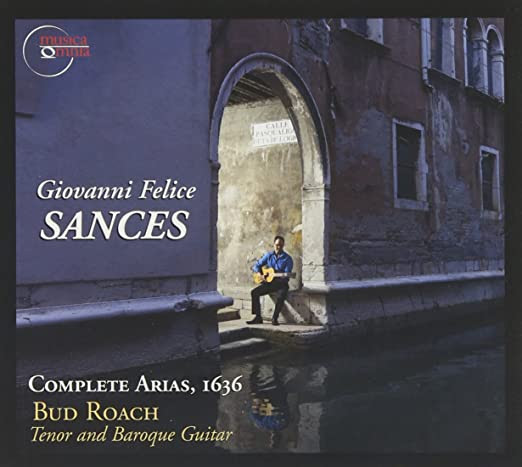
Bud Roach started his professional career as an oboist (he played in several American orchestras) but more recently has concentrated on singing and conducting. He is the director of Capella Intima, which in recent years has given us performances of the anonymous Giuseppe and of Gagliano’s Dafne. Both as a singer and as a director he specializes in Italian work of the early 17th century. His first recording as a tenor was of songs by Alessandro Grandi and he has now followed this up with a CD of arias by Giovanni Felice Sances, music first published in 1636. On both recordings he accompanies himself on the baroque guitar. I heard him perform these works at the Boston Early Music Festival Fringe in July 2013 and it gave me pleasure to renew my acquaintance with them. The final song on the disc (Accenti queruli) is not part of the 1636 edition: it is a chaconne which was such a prominent and influential form in the early baroque.
Roach’s voice is light but clear and distinctive; he has no problem with the high tessitura of many of the songs. Throughout he sings with real expressiveness. These songs can be seen as part of a Petrarchan tradition of erotic poetry but at the same time they show an affinity with popular song. They are now little-known and under-performed. Roach deserves credit for bringing this repertoire back to life.
From the Hamilton Spectator: You never know what gems you might find at the side of the road less travelled.
Take for instance Alessandro Grandi's third volume of secular arias dating from 1626. They were recorded for the first time ever by Hamilton-based tenor and Baroque guitarist Bud Roach in 2012 and released the following year on the Cambridge, Massachusetts-based Musica Omnia label. That disc garnered favourable comments in music magazines published on both sides of the pond not to mention Classical Recording of the Year at the 2013 Hamilton Music Awards.
So, for his followup CD on Musica Omnia, Roach has once again chosen something from the path less trod: the complete fourth volume of secular arias by Giovanni Felice Sances, published in Venice in 1636, plus his upbeat Accenti queruli, a pearl in volume two dating from 1633. Like Grandi, Sances is another musical underdog, a minor master from the early Italian Baroque era who to this day remains in the long shadow of his contemporary, Claudio Monteverdi.
"We have given short shrift to composers of Monteverdi's era, and we aren't as familiar with the music of his contemporaries as we should be," said Roach over the line from his Hamilton home. "So, I think that there's merit in recording a complete volume by one composer at one point in their stylistic development."
Just as record company execs may never have stumbled upon or bothered with Grandi before Roach's debut disc, the public has rarely, if ever, come across Sances's name. Yet, according to Roach, that lack of familiarity isn't universal.
"People in early music circles do know some of these Sances arias," said Roach. "Not all of them, but some of them."
Roach was turned on to Sances some six years ago when he met Lucas Harris, lutenist for the internationally acclaimed, Toronto-based period ensemble, Tafelmusik at one of their summer music institutes. Not only did Harris help Roach purchase a theorbo, he also filled him in on the self-accompanied aria, and gave him a photocopy of the entire fourth volume of Sances's arias. That was enough to whet Roach's appetite. Not long afterward, Roach sang a couple of those arias at a concert given by Harris's Toronto Continuo Collective, a period ensemble co-directed by harpsichordist Borys Medicky.
Born in Rome in 1600, Sances worked as a musician in Bologna, Venice, and lastly in Vienna from December 1636 until his death in 1679. His catalogue includes six operas and scads of sacred vocal music. According to Roach, Sances's three-minute arias were part and parcel of the popular music of his day in Italy.
"They were performed everywhere," said Roach of Sances's arias, which more than likely were accompanied by guitar. "In the street. In cafés. In private homes."
Make that everywhere except, of course, in church. Chalk that up to the texts Sances chose to set.
"Sances was a bit of a player because his texts are racy," said Roach. "His early stuff is all quite sexual in nature."
Hmm. The three-minute wonder extolling love and feminine virtues, or a lack thereof, the whole shebang sung by a man strumming a guitar on his lap? Si, amici. Truly, there is nothing new under the sun.
- Chiesi un bacio
- Fuggi, fuggi, mio cor
- Chi non sa cosa sia Amor
- Che pietà sperar si può
- O perduti diletti
- Già che non son Adone
- Occhi, occhi miei cari
- Se mille facelle
- Dove n’andrò
- Lagrime tutte amare
- Rapitemi, feritemi
- Superbetta, la mia vita
- Pietosi, allontanatevi
- Amanti, Amor è un gioco
- S’a sospir finti
- Il mio cocente ardore
- Accenti queruli
Composer Info
Alessandro Grandi, Alessandro Scarlatti, Giovanni Felice Sances
CD Info
Musica Omnia CD mo 0506, Musica Omnia CD mo 0803, Musica Omnia CD mo 0611
